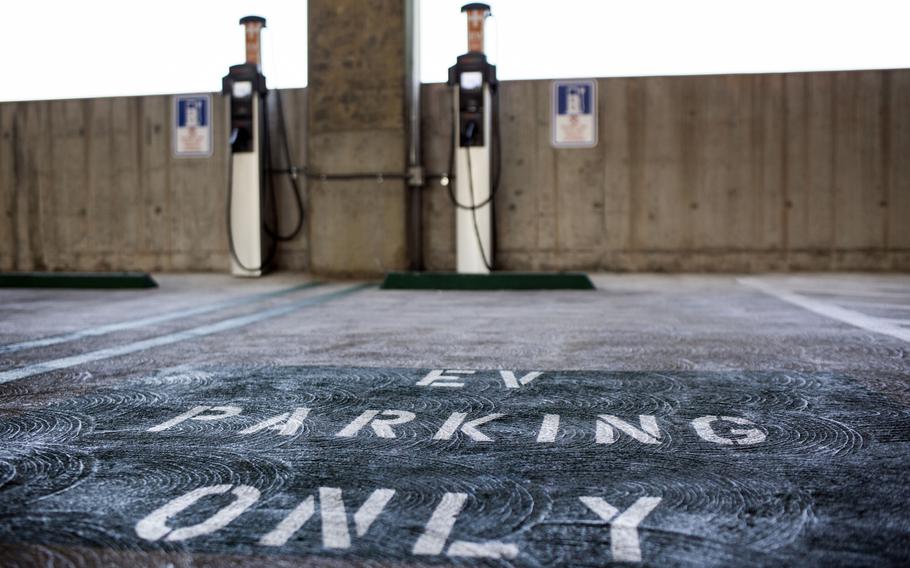
A sign reading “EV Parking Only” is seen on the ground in front of ChargePoint electric vehicle charging stations in a municipal parking lot in Los Angeles, Calif., on July 11, 2017. (Dania Maxwell/Bloomberg)
The American auto industry is in the midst of an “existential crisis” that will have profound implications for the national security of our country unless we change course.
In its ongoing quest to spur environmental change, the Biden administration has proposed ambitious tailpipe emission standards that aim to significantly increase the number of electric vehicles (EVs) on American roads. By 2032, the target is for up to two-thirds of new vehicles sold in the U.S. to be electric, a significant jump from the 8% of electric vehicles on the road in America today.
EVs will have a role in diversifying America’s transportation mix moving forward, but it’s crucial to not overlook the national security implications of rushing this transition. Such a rapid and drastic shift in our transportation infrastructure will increase American dependency on Chinese supply chains and flood the American market with their vehicles, as China has established a formidable foothold in the battery supply chains for EVs. This will leave us more vulnerable to political interference and spying from the Chinese Communist Party.
EVs use on average six times more rare-earth minerals than conventional cars, and China has worked for decades to develop a strategic dominance over these crucial resources. Today the communist country controls 70% of the extraction capacity and 90% of the processing capacity for critical minerals like lithium, cobalt and nickel. Similarly, they are the predominant producer of other critical battery components such as separators, electrolytes, cathodes and anodes. This leaves a strategic vulnerability that could be exploited anytime, but especially in a time of conflict as the Pentagon is undergoing a similar push to electrify more of its fleet and reach zero emissions by 2050.
The supply chain vulnerabilities are simply too serious and operational realities too great a hurdle to clear at this point. Our forces must operate across a range of temperatures and in austere conditions that often fall far outside the optimum temperature range of 68-86 degrees Fahrenheit for full battery efficiency. It will also take significant time to build out the infrastructure necessary to support military electric vehicle fleets in an expeditious manner and in the meantime, delays in charging electric vehicles in a combat environment could prove lethal. The fact remains that filling up a fleet of more reliable fossil fuel vehicles is much quicker and easier than charging one of electric vehicles and we cannot afford to give our enemies any advantage.
American automakers, meanwhile, are increasingly pulling back on EV production due to mounting losses. If the Biden administration continues with its current tailpipe emissions rule, this could leave a void for Chinese vehicles to fill in the market, a threat that one American automaker said could end its “future as a company.” This presents additional challenges to the integrity of American supply chains, leaving the military and other government sectors reliant on foreign production during critical times and impairing the ability of the United States to quickly mobilize resources in a national emergency.
Beyond supply chain risks, cybersecurity threats inherent in a future dominated by Chinese EVs cannot be understated. The rise of cyberwarfare as a tool by state and non-state actors has become a significant threat in recent years. EVs, like many modern technologies, are susceptible to hacking and cyberattacks. China has been known to put backdoors in the technologies they develop. An interconnected electric vehicle fleet would be a ripe target for state-sponsored cyberattacks. This would cripple transportation networks and/or enable spying at a national scale.
“If people are worried about a Chinese spy balloon going overhead, they would be worried about these Chinese EVs sending telematics back to China,” Heritage Foundation economist Diana Furchtgott-Roth said recently. Echoing the point, she continued that “car manufacturers now can disable cars remote. What if we were in some foreign entanglement with China? And then China decided to stop all the EVs in the United States? It’s a security risk.”
Proceeding with caution on this push toward electric vehicles is not just a suggestion; it’s an imperative. That is why I recently joined well over a dozen national security leaders and experts on a letter to the Biden administration arguing that any transition must be tempered with a comprehensive understanding of the associated risks and challenges.
Fortunately the White House appears to be heeding this advice and is reportedly considering relaxing some of the most aggressive targets in the tailpipe emissions rule. This is a promising start, but even more flexibility will likely be needed to ensure American interests are not undermined.
Moving forward, a balanced approach will be paramount. In military operations, the most successful plans are those that mitigate risks while advancing toward an objective. The transition to a sustainable future is no different. It demands a diversified energy strategy that considers the full spectrum of national security, from supply chain resilience and cybersecurity to environmental sustainability, economic stability and strategic autonomy.
Sergio de la Peña, a retired U.S. Army colonel, is a former deputy assistant secretary of defense for Western Hemisphere affairs.